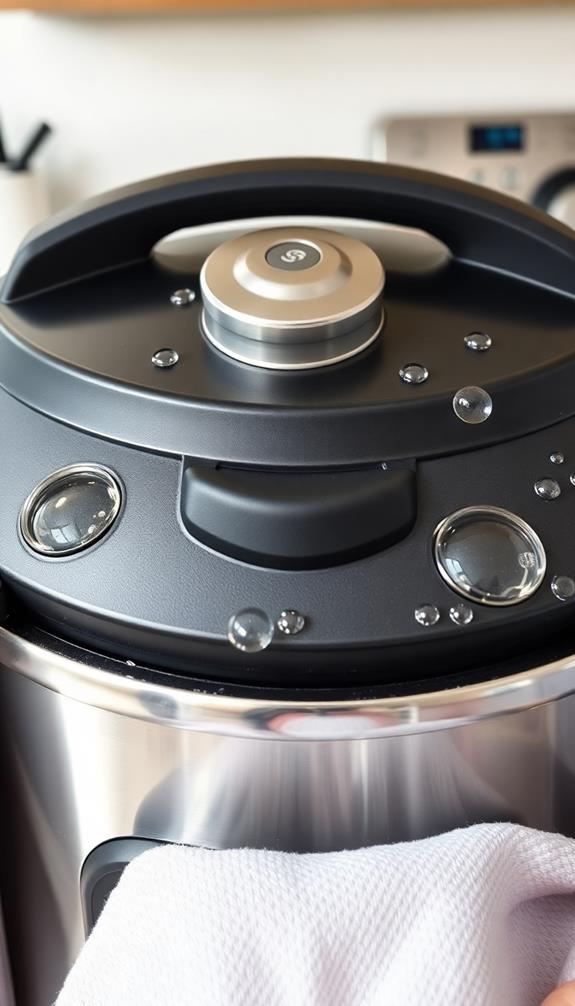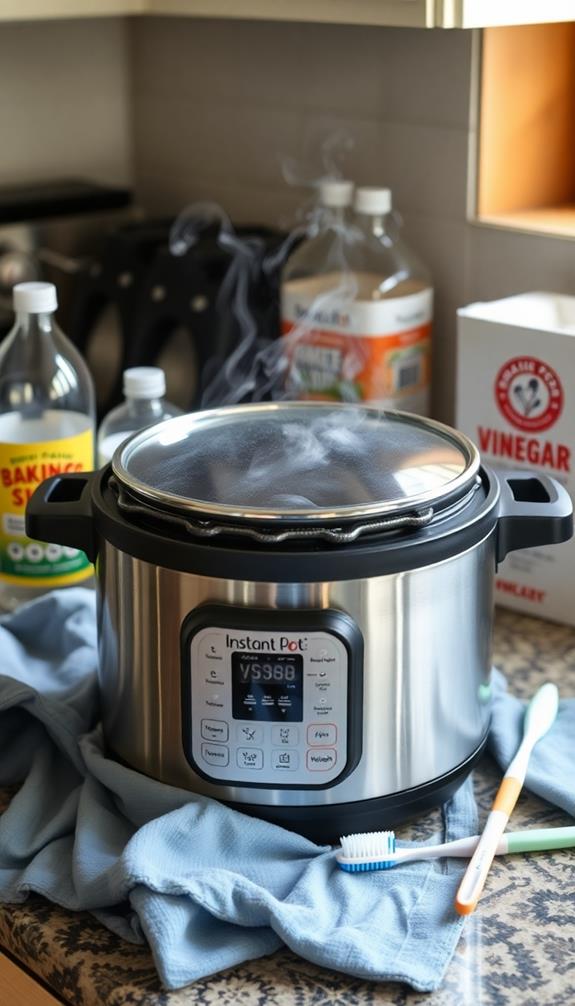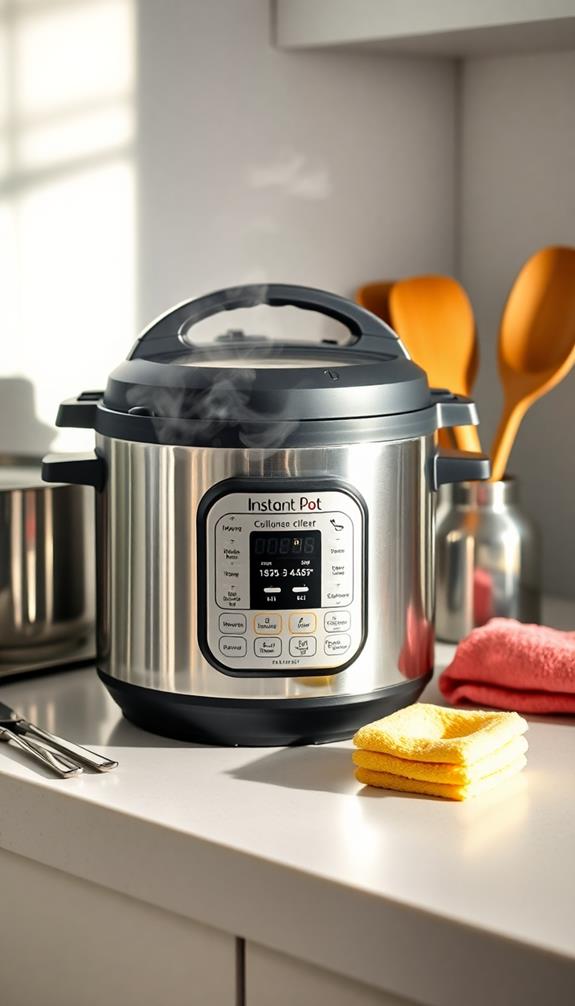Cleaning your Instant Pot safely is essential for ideal performance and tasty meals. Start by disassembling the lid and cleaning each part with warm, soapy water. Use a mixture of vinegar and water to tackle stains and odors. Regularly check the sealing ring for cracks and replace it every 12-18 months. Don't forget to clean the inner pot and steam rack in the dishwasher as needed. Store the lid upside down for airflow to prevent odors. For more tips and detailed cleaning techniques, there's plenty more you'll want to explore.
Deep Cleaning Techniques
When it comes to deep cleaning your Instant Pot, you'll want to follow a few effective techniques to keep it in prime shape. Start by deep cleaning the inner pot. Combine 2 cups of water with 1 tablespoon of baking soda and a squirt of dish soap. Pressure cook this mixture for 4 minutes, then allow for natural release. This method helps break down food residue effectively, similar to how non-toxic cleaning solutions work to maintain a safe and hygienic kitchen environment.
Next, address the lip of the pot. Use a butter knife wrapped in a damp rag to meticulously clean it, ensuring no food residue is left behind. To tackle any white stains on your stainless steel pot, mix vinegar and baking soda. Allow it to fizz for a few minutes, then gently scrub with a non-abrasive pad.
Don't forget to check the plastic cup at the back of the Instant Pot regularly. Cleaning it helps prevent odor buildup and maintains peak performance.
Managing Stainless Steel Stains
Managing stainless steel stains can feel challenging, but with the right approach, it's easier than you think. To keep your stainless steel cookware looking fresh and shiny, follow these essential tips:
Regularly clean the inside of your pot using white vinegar to achieve a shiny finish and remove minor stains, as vinegar acts as an effective natural cleaning agent. For tougher stains, apply Bar Keepers Friend with a damp rag, then rinse with soapy water to eliminate any residue.
Use a stainless steel cleaner specifically designed for cookware to remove bluish marks caused by mineral deposits. Avoid using abrasive materials like steel wool, as they can scratch the surface and lead to permanent damage.
To manage and prevent water stains, make it a habit to wipe the inner pot dry after each use. Additionally, periodically descale your pot with a mixture of equal parts vinegar and water.
Lid and Component Care

Cleaning your Instant Pot lid is essential for maintaining its performance and preventing odors.
Establishing a regular cleaning routine helps guarantee that your lid remains in peak condition, much like daily care and maintenance for kitchen sinks can reduce bacteria and odors.
Start by disassembling the lid—remove the steam release handle, sealing ring, and anti-block shield—and wash each part in warm, soapy water.
Don't forget to regularly check the sealing ring for cracks and use a vinegar and lemon mixture to keep it fresh!
Disassembly and Cleaning Steps
To keep your Instant Pot functioning at its best, disassembling and cleaning the lid and its components is essential. Start by carefully removing the steam release handle, sealing ring, and anti-block shield. This disassembly allows for thorough cleaning and inspection.
Here's what you should do next:
- Clean the sealing ring and anti-block shield in warm, soapy water to eliminate odors and residue.
- Use a damp cloth to wipe the lid, ensuring the steam release valve and float valve are free from any food particles or debris.
- Allow the sealing ring and anti-block shield to dry completely before reassembly.
- Regularly inspect the sealing ring for cracks or damage, replacing it every 12-18 months for ideal sealing performance.
Once everything is clean and dry, reassemble the components carefully.
When not in use, store the lid upside down on the pot to promote airflow and prevent odor retention.
Deodorizing Sealing Ring Techniques
A fresh-smelling sealing ring is essential for your Instant Pot's performance, as lingering odors can transfer to your dishes.
To effectively deodorize the sealing ring, mix 1 cup of water and 1 cup of vinegar, adding lemon rind for an extra fresh scent. Secure the lid and set your Instant Pot to steam for 3 minutes. Once done, remove the sealing ring and let it air dry completely to prevent any persistent smells.
For best results, consider using separate sealing rings for savory and sweet dishes to avoid flavor transfer.
If you encounter strong odors that won't budge, try using denture cleaning tablets or a hydrogen peroxide solution for a deep clean.
Regularly inspect your sealing ring for signs of damage or wear, as a compromised ring can affect your cooking.
To maintain freshness and functionality, you should replace the sealing ring every 6 to 12 months.
Essential User Tips
To keep your Instant Pot in top shape, regular maintenance is key. You can use effective cleaning techniques, like vinegar solutions and Q-tips, to tackle tough spots and prevent odors.
Additionally, utilizing eco-friendly alternatives like effective natural cleaning agents can enhance your cleaning routine.
Regular Maintenance Importance
Regular maintenance is key to keeping your Instant Pot in top shape and guaranteeing it operates safely and efficiently. By committing to a few essential tasks, you can enhance its performance and extend its lifespan.
- Clean removable components after each use to prevent food residues and odors.
- Inspect the sealing ring every 12-18 months for any cracks or deformation.
- Regularly clean the anti-block shield and steam release valve to avoid blockages.
- Use a vinegar and water mixture for deep cleaning to maintain functionality and appearance.
Incorporating these practices into your routine not only guarantees your Instant Pot works effectively but also keeps it hygienic.
Inspecting the sealing ring is vital for pressure cooking safety, while regular cleaning helps avoid unpleasant smells. When you store your Instant Pot with the lid upside down, it promotes airflow and reduces odor buildup.
Prioritizing regular maintenance isn't just about aesthetics; it bolsters the overall functionality of your appliance. Taking these steps will pay off in the long run, allowing you to enjoy delicious meals without hassle.
Effective Cleaning Techniques
Cleaning your Instant Pot effectively is crucial for maintaining its performance and hygiene. Start by regularly cleaning the inner pot and steam rack after each use. You can do this with warm, soapy water or simply toss them in the dishwasher. This guarantees you're ready for your next meal without any lingering odors.
For descaling your Instant Pot, mix equal parts water and vinegar. Run a steam cycle for 2-3 minutes to remove any mineral buildup, keeping your appliance in top shape.
Don't forget about the silicone sealing ring; soak it in a mixture of water, vinegar, and lemon rind, then steam for 3 minutes before letting it air dry to eliminate odors.
If you notice tough stains on the stainless steel inner pot, use Bar Keepers Friend with a non-abrasive pad, scrubbing gently. Rinse thoroughly with soapy water afterward.
Odor Prevention Strategies
Preventing odors in your Instant Pot is essential for maintaining a pleasant cooking experience. Here are some effective odor prevention strategies to keep your appliance smelling fresh:
- Store your Instant Pot lid upside down to promote airflow and prevent odors from developing in the sealing ring.
- After cooking strong-smelling foods, clean the sealing ring regularly to avoid flavor transfer.
- Use a mixture of 1 cup water and 1 cup vinegar with lemon rind for steam cooking. This deodorizes the sealing ring in just 3 minutes.
- Air dry the sealing ring completely after cleaning and store it in a well-ventilated area.
If you encounter persistent odors, consider deep cleaning your sealing ring with denture cleaning tablets or hydrogen peroxide solutions.
These methods help guarantee effective odor prevention and maintain the integrity of your Instant Pot. By implementing these tips, you'll enjoy a fresher cooking environment and avoid any unwelcome smells that can linger from previous meals.
Addressing Common Issues

Maintaining your Instant Pot's functionality is essential for a smooth cooking experience. One common issue is a faulty sealing ring. Verify it's correctly positioned and free of cracks or food debris that could prevent a tight seal.
If you encounter error codes on the display, don't panic—refer to the user manual for troubleshooting steps specific to that code. Regular maintenance, including weekly cleaning with soapy water, can help prevent these issues from arising.
Another potential problem is a stuck float valve. Check for any food debris blocking it and clean it thoroughly to verify proper operation.
If you notice food burning on the bottom of the pot, inspect the heating element for residue. Regular cleaning of this area helps maintain efficient heat distribution and prevents future cooking mishaps.
Additionally, keep an eye on the power cord. Regular inspections for any signs of damage can help you avoid electrical issues that may lead to unsafe operation of your Instant Pot.
Safe Cleaning Supplies
Keeping your Instant Pot in prime condition goes beyond regular inspections and maintenance. Using the right safe cleaning supplies is essential for preserving its functionality and appearance. You want to guarantee that your cleaning methods are effective yet gentle on the surfaces.
Consider incorporating some green cleaning methods to enhance your cleaning routine. Here are some recommended options:
- White distilled vinegar: A natural deodorizer and stain remover for the stainless steel pot and sealing ring.
- Baking soda: An eco-friendly option for deep cleaning; mix it with water and dish soap, then pressure cook for 4 minutes to cleanse the inner pot thoroughly.
- Bar Keepers Friend: This product is great for tackling tough stains, providing a non-abrasive solution to maintain shine without scratching.
- Food-safe cleaning supplies: Always opt for eco-friendly cleaners to maintain a healthy cooking environment and avoid chemical sensitivities.
Remember to avoid harsh chemicals and abrasive cleaners, as they can damage your Instant Pot surfaces and lead to residue buildup.
Maintenance of Instant Pot

Regular maintenance of your Instant Pot is essential for guaranteeing its longevity and best performance. Start by regularly inspecting and cleaning the sealing ring every 12-18 months. This helps prevent odors and guarantees a proper seal during cooking.
After each use, make sure to clean the anti-block shield to keep food particles from blocking the steam release valve, which can lead to pressure issues. For an extra layer of cleanliness, you might consider using disinfectants on your kitchen surfaces, such as top-rated disinfectant sprays, to maintain a germ-free environment while preparing meals.
The inner pot and steam rack are dishwasher safe, but for tough stains, consider using a mixture of white vinegar and warm soapy water for effective cleaning. After washing, always dry the cooker base thoroughly to keep it free from moisture, protecting the electrical components from damage.
When storing your Instant Pot, place the lid upside down to promote airflow and reduce the risk of odor retention in the sealing ring.
Understanding Instant Pot Features
The Instant Pot is a versatile kitchen appliance that combines multiple cooking functions into one convenient device. With various models like the Lux 6-in-1 and Duo 7-in-1, you can explore a range of cooking program options tailored to your needs, including:
- Pressure cooking for faster meals
- Sauté function with three heat settings
- Rice cooking modes for perfect texture
- Cleaning functions for easy maintenance
One standout feature is the sauté function, which allows you to simmer, sear, or brown ingredients effectively. You can choose from three heat settings: Less, Normal, and More.
Additionally, the rice cooking modes help you achieve various textures, from firm grains to softer white rice. Regular maintenance, such as top kitchen sink maintenance hacks, can also help keep your cooking area tidy and safe.
Safety is paramount when using your Instant Pot, thanks to built-in safety mechanisms like the steam release valve and anti-block shield. The stainless steel inner pot and sealing ring guarantee a secure cooking environment.
Understanding these features not only enhances your cooking experience but also makes cleaning easier. By familiarizing yourself with these options, you can maximize the potential of your Instant Pot while guaranteeing its safe and efficient operation.
Conclusion
In summary, keeping your Instant Pot clean not only extends its lifespan but also guarantees delicious meals every time. By following the deep cleaning techniques and caring for its components, you'll be right as rain. Remember to use safe cleaning supplies and address any common issues promptly. With a little maintenance and understanding of its features, your trusty kitchen companion will serve you well for years to come. So, roll up your sleeves and get to cleaning!